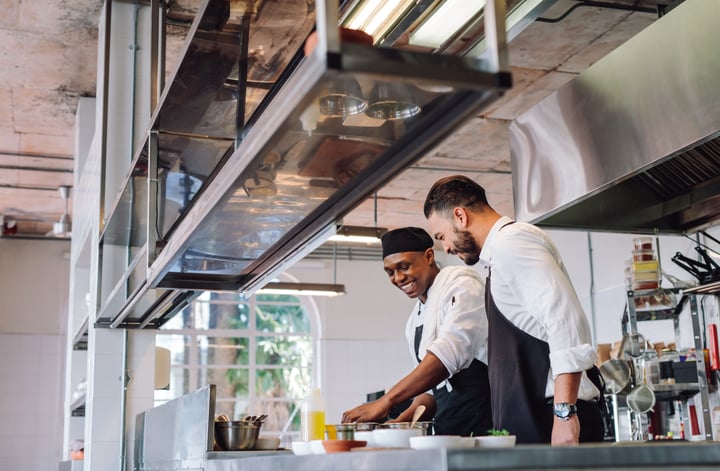
- Home
- Crunchtime Blog
- How to Build Great Teams in Multi-Unit Restaurants

How to Build Great Teams in Multi-Unit Restaurants
Multi-unit restaurant operators know that running great restaurants depends on having great teams, but it can be difficult for restaurants to consistently maintain quality staff. During Crunchtime’s webinar, How to Drive Customer Experience, Profitability & Growth through Ops Excellence, experienced leaders from across the restaurant industry explored the driving factors behind top-performing restaurants and found the common denominator: great teams.
Great teams can be hard to come by in the service industry. With entry-level employees, the pandemic caused a ‘staffing crunch’ where many restaurants found themselves understaffed and undertrained. Even now, countless restaurants’ staffing levels have not rebounded. John “JZ” Zurovchak, Senior Operations Director at Burger King, described the “battlefield promotions” that many restaurants resorted to, where employees were promoted to management positions without the usual training process or timeline. Staffing a restaurant with untrained managers and team members can feed into the seemingly never-ending cycle of revolving door turnover, where employees seem to leave as quickly as they can be hired.
With labor costs up 18.3% since 2019, according to the 2023 State of the Restaurant Industry Report by the National Restaurant Association, many might think that restaurants are back to being fully staffed after the pandemic, but that is not the case. 62% of restaurants are still reporting that they’re understaffed.
Despite this, Zurovchak pointed out that not all restaurant locations felt the same amount of pressure during the staffing shortage,
“What we’ve found is that it really comes down to the basics. Restaurants that have great leadership and great culture are able to bring new hires in and retain them, and they are able to stay staffed at the levels that they need to be at. The pandemic had an impact and exposed the restaurants that may not have had that leadership.”
.jpg?width=600&height=400&name=600x400%20px%20image%20crop%20(30).jpg)
How to build great restaurant teams
A thoughtful approach to onboarding and training can set restaurants up for success when it comes to building great teams. Zurovchak explained, “Training and operations go hand in hand, so what we’ve done is doubled back and zeroed in on how do we bring a new hire into a restaurant and onboard them in a way that makes them feel like they are part of something else- part of a culture without being overwhelmed."
Zurovchak also believes that finding ways to make new hires feel valued and included can positively impact how long employees stay with the company. “We try to bring them in and make them feel that they’re part of the team and also that they’re contributing to the guest experience, Focusing on our team member value propositions as well as the onboarding process and getting that into the system because if we do that well, we can show [new hires] that we have a lot to offer when it comes to a career. When done correctly, you see that ‘staffing crunch’ go away because the culture is vibrant, the leadership is there, and people stay.”
It is vital to streamline the recruiting and onboarding process, and technology can play a key role. Zurovchak suggested evaluating how you interact digitally with potential new hires during the hiring and onboarding process. “We want to engage with them and talk to them and to take quick ‘pulse surveys’ to see how they are doing and feeling during the onboarding process. We want to make sure that one: they are comfortable, and two: they have the training they need to do their job.”
When it comes to promotions, Zurovchak believes that there needs to be an alternative to the ‘battlefield promotions’ that happen out of urgently needing a manager role filled. The alternative strategy involves creating clear promotion pathways throughout the organization. “We need to have a formally structured learning and development path from team member all the way up to District Manager. We want to show them a career in the industry.”
In the quick service industry, it is not common to have vetted and trained employees prepared for a promotion when a management vacancy occurs. “Can you imagine a professional sports team doing that?” asked Zurovchak. Sports teams’ process of having backups for key players can be translated to restaurants, helping ensure that stores will never have disruptions in management due to vacancies.
Utilizing technology to smooth out the experience for team members doesn’t have to stop at onboarding and training. Deane Fischer, Franchise Business Consultant at Culver’s, explained how the ability to digitally onboard team members allows them to have “everything at their fingertips 24/7, with their schedule, time-off requests. All of that has made the process much slicker for employees.”
-1.jpg?width=600&height=400&name=600x400%20px%20image%20crop%20(31)-1.jpg)
Brandon Blosser, Senior Manager of Process Innovation at Chipotle, explained how technology can also be used during daily operations to help maximize employees’ time and energy. “We are using technology to enable our managers and crew members to deliver a great guest experience. Every single task that you could digitize or streamline is time that you are freeing up for team members to be face-to-face with guests delivering a great customer experience.”
Finally, Fischer emphasized an unavoidable component of great teams: role models. “I need to lead by example. Servant leadership is the core of who I am. If I don’t lead by example, then what business do I have to even be a leader? People feed off of their leaders and learn from them.”
To learn more about how to staff your restaurants with great leadership, check out our blog, How to Find, Train, and Maintain Top-Performing GMs.
Share this post
Related


How to Find, Train, and Maintain Top-Performing GMs

